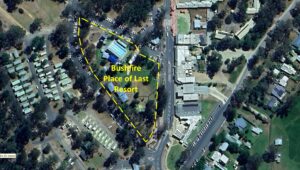There have been concerns in the past about communities not understanding what a “neighbourhood safer place” is in the event of a fire. The full name for these places is – Neighbourhood Safer Places – Bushfire Places of Last Resort. The following will hopefully clarify what it means, if in the event of an emergency you need to access one.
What is a Neighbourhood Safer Place?
Neighbourhood Safer Places – Bushfire Places of Last Resort (NSPs) are places of last resort when all other bushfire plans have failed. They are locations that may provide some protection from direct flame and radiant heat, but they do not guarantee safety. They are not an alternative to planning to leave early or to stay and defend your property; they are a place of last resort if all other fire plans have failed.
An NSP is an existing location, not a purpose-built, fire-proof structure. An NSP may be at a local sports field, foreshore or park, or they may be located within a community facility such as a hall, community centre or school. It is important to know that NSPs are not always a building or structure – they can simply be a clearing that provides a level of protection from radiant heat. NSPs are identified with a green and white sign which includes the words ‘Bushfire Neighbourhood Safer Place – A Bushfire Place of Last Resort’.
Who establishes NSPs?
NSPs are established by local government and not all townships have one. Councils identify, designate and maintain Neighbourhood Safer Places – Bushfire Places of Last Resort. Councils request CFA to assess potential NSPs. The basic principle of an NSP is that it may afford some protection from radiant heat, the biggest killer during bushfire. CFA’s criteria for NSPs are based on radiant heat calculations taking significant vegetation into account. Each site will be evaluated on its own merit. CFA assess potential NSPs to ensure sites will not exceed the prescribed maximum potential for radiant heat exposure, and provides its assessment to the relevant council.
What can I expect to find at an NSP?
In a fire, the CFA or other emergency services may not be present at an NSP. NSPs may not have the capacity to cater for special needs. There will be no support services (food or drink, material aid) or provision for pets. NSPs may not provide shelter from the elements, particularly from heat and flying embers. On Extreme and Catastrophic Fire Danger Rating days, the temperature is likely to be more than 35°C and the heat and sun will impact on those who shelter at an NSP. Safety and survival cannot be guaranteed at an NSP and there may be no support or services provided. NSPs will offer limited protection against radiant heat and embers. Travelling to a place of last resort is dangerous. Traffic congestion, fire activity, accidents or fallen trees may block the route. Visibility is likely to be extremely poor due to smoke. People sheltering at an NSP are likely to experience extreme conditions such as heat, high winds, fire noise, and exposure to embers and radiant heat and may experience breathing difficulties due to smoke and ash.
NSPs will not guarantee a person’s safety. They are places of last resort to shelter during a fire front when all other plans have failed. NSPs are places of absolute last resort.
Where is the NSP in Halls Gap?
Our NSP is represented by the grassed area at the Halls Gap playground and picnic reserve between Grampians Road and School Road,
